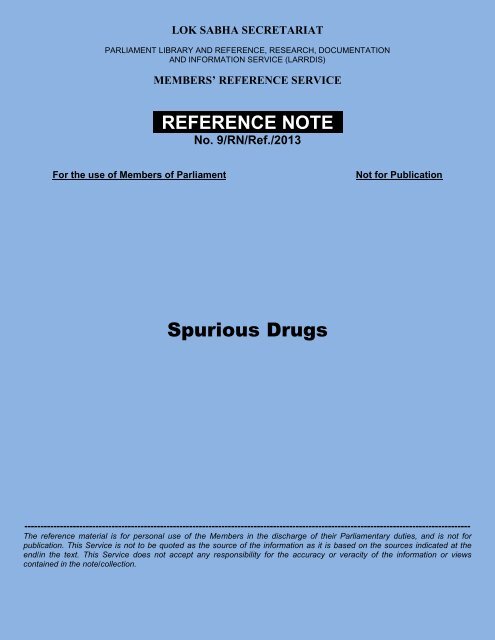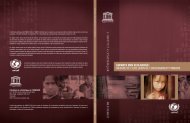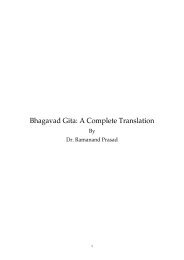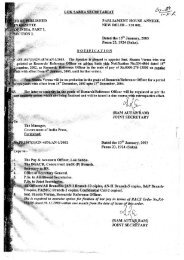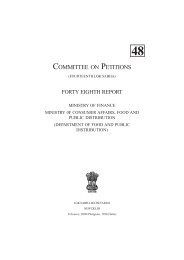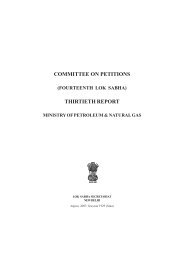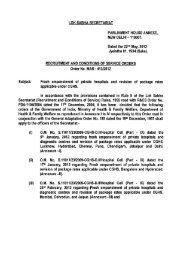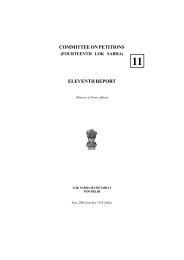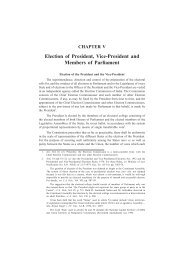Spurious Drugs
Spurious Drugs
Spurious Drugs
- No tags were found...
You also want an ePaper? Increase the reach of your titles
YUMPU automatically turns print PDFs into web optimized ePapers that Google loves.
LOK SABHA SECRETARIATPARLIAMENT LIBRARY AND REFERENCE, RESEARCH, DOCUMENTATIONAND INFORMATION SERVICE (LARRDIS)MEMBERS’ REFERENCE SERVICEREFERENCE NOTE .No. 9/RN/Ref./2013For the use of Members of ParliamentNot for Publication<strong>Spurious</strong> <strong>Drugs</strong>------------------------------------------------------------------------------------------------------------------------------------------The reference material is for personal use of the Members in the discharge of their Parliamentary duties, and is not forpublication. This Service is not to be quoted as the source of the information as it is based on the sources indicated at theend/in the text. This Service does not accept any responsibility for the accuracy or veracity of the information or viewscontained in the note/collection.
<strong>Spurious</strong> <strong>Drugs</strong>IntroductionA drug shall be deemed to be spurious if it is manufactured under a name whichbelongs to another drug, if it is an imitation of another drug or if it has been substitutedwholly or partly by another drug or if it wrongly claims to be the product of anothermanufacturer. The term „<strong>Spurious</strong> Drug‟ has been defined under Section 17-B of the<strong>Drugs</strong> and Cosmetics Act, 1940, as amended by the <strong>Drugs</strong> and Cosmetics(Amendment) Act, 1982. A stringent penalty for manufacture and sale of spurious drugshas also been prescribed under the Act. Counterfeiting of commercial products,including medicines, is a global issue and is reported in many countries. Circulation ofspurious drug can lead to grave, adverse consequences on both consumers (patients)and genuine manufacturers. According to State Drug Controller, the extent of circulationof spurious drug is about 0.3 per cent. The Government is aware of the problem ofmovement of spurious drugs in the market and has taken serious note of it 1 .Under the provisions of <strong>Drugs</strong> and Cosmetics (Amendment) Act 2008 and Rulesthereunder, it is the joint responsibility of Central and State Governments through theirrespective Drug Control Organizations to regulate manufacture and sale of drugs aswell as to keep surveillance over possible movement of spurious drugs.Manufacture and sale of spurious drugs is primarily a clandestine activity. To thisextent, it is difficult to detect the manufacture or movement of spurious drugs. A study ofsamples of drugs tested all over the country during the last 10 years reveals that about0.2 per cent to 0.4 per cent of around 40,000 samples fall within the category ofspurious drugs. A statement showing the number of samples tested, number of samplesdeclared not of standard quality, number of samples declared spurious, number ofprosecutions launched, number of persons arrested and the approximate value of drugs1 Report on Countrywide Survey for <strong>Spurious</strong> <strong>Drugs</strong>, Central <strong>Drugs</strong> Standard Control Organisation (CDSCO),Ministry of Health and Family Welfare, 2009, p.3
-2-seized State / UT wise during 2009-10, 2010-11, 2011-12 and from April-July, 2012 isgiven at Annexure.However, keeping in view the serious implications of spurious drugs on publichealth as well as the loss to genuine industry, the Government has taken variousmeasures to combat this menace 2 .Mashlekar CommitteeThe apprehensions about the availability of safe and genuine medicines in India,is in a way causing concern to the consumers within the country, on the other affectingthe credibility of drug products from India. Hence, the Government had set up an ExpertCommittee under the Chairmanship of Dr. R.A. Mashelkar, the then DG (CSIR) inFebruary, 2003 to recommend measures for strengthening the drug regulatory systemin the country as well as tackling the problem of spurious drugs 3 .The Committee which submitted its report in November, 2003 had recommendedseveral changes in the penal provisions of the <strong>Drugs</strong> & Cosmetics Act. The mainrecommendations of the Committee are as follows:-i) Enhancement of penalty, for sale and manufacturing of spurious drugs thatcause grievous hurt or death, from life imprisonment to death.ii)iii)iv)Sale and manufacture of spurious drugs, which are not likely to causeconsequences as stated in (i) above, be made cognizable and non-bailable.There should be a penalty for those who are unable to produce documents insupport of their purchase.There should be a provision for compounding of minor offences so that theseshould be disposed of expeditiously while prosecution is able to concentrate onserious cases in the appropriate courts.v) Authorization of the police to file prosecution.2 Ibid3 Ibid
-3-vi)Constitution of special courts for trial of offence under the <strong>Drugs</strong> & Cosmetics Actso that judicial proceedings can be expedited.vii) Enhancement of prison terms and fines for different offences, including theconcept of damages 4 .In the tune of recommendations given by the Mashelkar Committee a bill waspassed in both the houses of Parliament and the bill had been notified as The <strong>Drugs</strong>and Cosmetics (Amendment) Act, 2008.The <strong>Drugs</strong> and Cosmetics (Amendment) Act, 2008The <strong>Drugs</strong> and Cosmetics Act, 1940 was amended by the <strong>Drugs</strong> & Cosmetics(Amendment) Act, 2008 to provide for more stringent penalties for manufacture andtrade of spurious and adulterated drugs. Apart from other provisions, the respective Billsought to achieve the following objectives:(i)To enhance the period of imprisonment for a term which shall not be less thanten years but which may extend to imprisonment for life and shall also be liable tofine of ten lakh rupees or three times the value of the drugs confiscated,whichever is more;(ii) To provide that the fine imposed on the convicted person and realised from himunder the said clause shall be paid to the person who used such adulterated orspurious drugs and in case of his death, to his relative;iii) To designate one or more Court of Session as Special Court for trial of offencesrelated to adulterated or spurious drugs; 14 States/UTs have already set upthese special Courtsiv) To make offences relating to adulterated or spurious drugs as cognizable andnon-bailable in certain cases;v) To confer upon the police officers not below the rank of sub-inspector of policeand other officers of the Central Government or State Government authorised byit to institute the prosecution under the aforesaid Act;vi) To provide compounding of certain offences not being an offence punishable withimprisonment only or with imprisonment and also with fine, etc 5 .4 Ibid, p. 45 <strong>Drugs</strong> and Cosmetics (Amendment) Act, 2008
-6-chapter IV of the Act, administrative measures including suspension/cancellation orcompounding of offences may be resorted to. Prosecution may only be launchedwhere it is justifiably felt that above measures would not meet the ends of justice.6. Section 36 AC which makes certain offences under the Act cognizable and nonbailablehas been inserted to facilitate the arrest of anti-social elements involved inthe manufacture of spurious or adulterated drugs.7. The State Drug Control Departments shall constitute screening committeescomprising of at least three senior officers not below the level of Assistant <strong>Drugs</strong>Controllers or equivalent to examine the investigation reports of the cases whereprosecutions are proposed to be launched.8. Prosecutions by the Inspectors shall be launched on the basis of writtenpermissions of the controlling authority and this authority in turn shall consider therecommendations of the screening committee while taking final decision in thematter.9. The Patent and Proprietary formulations should be tested by the Governmentanalysts as provided under Rule 46 of the <strong>Drugs</strong> and Cosmetics Rules.10. The <strong>Drugs</strong> Consultative Committee had earlier in 1993 approved detailedguidelines for taking action in specific cases on reports of not of standard qualitydrugs.11. Co-ordination between regulatory authorities is key to success in taking timelyaction in cases of violation of the provisions of the <strong>Drugs</strong> and Cosmetics Rules.12. The State Drug Control Organizations shall create a rapid alert system so that anyvital information in the cases of spurious/adulterated drugs is passed on to theappropriate authorities quickly for taking further action in the matter.13. For combating the menace of spurious/adulterated drugs a robust infrastructure isessential to implement the provisions of the <strong>Drugs</strong> and Cosmetics Act 8 .Whistleblower SchemeSince spurious or fake drugs is a sensitive issue affecting the health of thecitizens as well as the prestige of the country‟s pharmaceutical trade interests, there is asense of urgency in taking on the menace on priority basis. In eradicating the menace ascheme has been devised by the Central Government for giving monetary rewards tothe whistleblowers who can take risk of providing the information about the perpetrators8 Ibid, pp. 4-6
-7-of such crime. The Reward Scheme provides for giving handsome rewards to theinformers who provide specific information to the designated authorities leading to theseizures of spurious, adulterated, misbranded and not of standard quality drugs,cosmetics and medical devices. This Reward Scheme will be applicable to both theinformers as well as the officers of the Central <strong>Drugs</strong> Standard Control Organisation(CDSCO). In the fight against the menace of spurious or fake drugs, cost of such socialparticipation will be minimal given the proportion of damage inflicted by the perpetratorsof the crime on the health of the society and the economic progress of the country.The salient features of the aforesaid Reward Scheme 9 are as follows:-(i)The reward scheme shall be applicable for whistleblowers in the area of drugs,cosmetics and medical devices.(ii) Reward is to be given to the whistleblowers i.e. the informers / officials only whenthere is a confirmation of the seizure of spurious, adulterated and misbranded drugs,cosmetics and medical devices by the designated officers of the CDSCO.(iii) The reward of maximum of upto 20 per cent of the total cost of consignments seizedwill be payable to the informer / officials which should not in any case exceed Rs 25Lakh in each case.(iv) In respect of an officer of the Government / CDSCO, the reward should not in anycase exceed Rs 5 Lakh for one case and a maximum of Rs 30 Lakh in his / herentire service.(v) With a view to ensure that the informers are not made to wait till the final disposal ofthe matter, 25 per cent of the amount will be given at the time of filing of the chargesheet in the court of Law.(vi) Further, with a view to ensure that the informers do not turn hostile during the trial ofthe case and continue to assist the court in deciding the matter in favour of theGovernment, 25 per cent of the amount will be given to them at the time of disposalof the case in favour of the Government in the first court of law.(vii) The remaining 50 per cent amount will be paid only when the case has been finallydisposed of in favour of the Government and no appeal with respect to the matter ispending in any other Court of Law in the country.(viii) The eligibility of the informer and the quantum of cash rewards would be decided bya Committee, which will consist of officials from different departments / offices.9 Reward Scheme for Whistleblowers, CDSCO
-8-(ix) The eligibility of Government servants for the rewards shall be decided by theCommittee depending upon the final outcome of the case only.(x) The Government will engage senior advocates who have sufficient experience of thecases relating to <strong>Drugs</strong> as its counsel in the cases.(xi) To ensure speedy trials of the cases, these cases will be filed before theDesignated/Special Courts set up for the purposes of drugs related issues as per theprovisions of the <strong>Drugs</strong> and Cosmetics (Amendment) Act, 2008.(xii) Special instructions are to be given to the Drug testing laboratories to send theirreports at the earliest, within the minimum time possible, so that the matter isdisposed of expeditiously.(xiii) Drug Controller General (India) along with other officials will be the nodal authoritywho will inter alia oversee the functioning of the Reward Scheme as proposed hereinabove.(xiv) The zonal and sub-zonal officers of the CDSCO will act as the nodal officer to whomthe whistle blower / informer can provide the information about the manufacture /movement of spurious / adulterated drugs.(xv) The identity of the whistle blower / informer will be kept secret and will be knownonly to the concerned zonal and sub-zonal officers of the CDSCO, the DCG(I) andthe Director General Health Services. It will be the responsibility of the concernedofficials to keep the details of the whistle blower / informer secret.(xvi) The identity of the whistle blower / informer will not be disclosed to the committee.(xvii) On receipt of the information from the whistle blower / informer, the concernedofficers will organize immediate and systematic investigation in co-ordination withthe State <strong>Drugs</strong> Control Administration to unearth the spurious drugs racket.(xviii) As the Licenses are granted by the State <strong>Drugs</strong> Control Authorities, they will takesuitable action like prosecution etc depending upon the evidences available in thecase.(xix) The details of the investigations will then be forwarded by the concerned zonal / subzonalofficer to the DCG(I) for the consideration of the committee to decide about themerit of the case for reward and the quantum of reward to be given to the whistleblower / informer.(xx) The details of the nodal authority and the zonal / sub-zonal officers of the CDSCOfor the purposes of this reward scheme, to whom the concerned information may begiven by the whistle blower / informer, are as follows:
-9-Central <strong>Drugs</strong> Standard Control OrganisationThe Central <strong>Drugs</strong> Standard Control Organization (CDSCO) is the Central DrugAuthority for discharging functions assigned to the Central Government under the <strong>Drugs</strong>and Cosmetics Act.Major functions of CDSCO 10 :1. Regulatory control over the import of drugs, approval of new drugs and clinical trials,meetings of <strong>Drugs</strong> Consultative Committee (DCC) and <strong>Drugs</strong> Technical AdvisoryBoard (DTAB), approval of certain licences as Central Licence Approving Authorityis exercised by the CDSCO hqrs.2. Zonal offices carry out joint inspections and coordinate with the State <strong>Drugs</strong>Controllers under their jurisdiction.3. Quality control of drugs imported is exercised by the port offices.4. <strong>Drugs</strong> testing laboratories test drug samples forwarded to them for test.A survey to assess the extent of spurious drugs in the country was conducted inthe year 2009 by the Ministry of Health, through Central <strong>Drugs</strong> Standard ControlOrganisation (CDSCO) on the basis of statistical principles provided by Indian StatisticalInstitute (ISI), Hyderabad. The survey has revealed that the extent of drugs foundspurious was only 0.046 per cent.A system of registration of import of cosmetics has been introduced under theGazette notification GSR 426(E) dated 19.05.2010. The registration of cosmetics willbecome mandatory from 1.04.2012.The following initiatives have been undertaken in the enforcement of the <strong>Drugs</strong>and Cosmetics Rules:10 CDSCO, Ministry of Health and Family Welfare
-13-S. No. States No. ofdrugssamplestestedNumber of samples tested and enforcement actions takenby State <strong>Drugs</strong> Controller during 2010-11No. ofdrugssamplesdeclarednot ofstandardqualityNo. of drugssamplesdeclaredspurious/adulteratedNo. ofprosecutionlaunchedNo. ofpersonsarrestedApproximatevalue ofdrugs seized(In Lakhs.)1 Andhra Pradesh 4052 52 1 1 Nil 0.0042 Arunachal Pradesh 2 Nil Nil Nil Nil Nil3 Assam 760 63 1 1 Nil 0.9594 Bihar 2359 58 8 39 24 22.905 Goa 642 26 Nil 1 Nil Nil6 Gujarat 5037 317 6 17 Nil Nil7 Haryana 2348 67 1 4 Nil Nil8 Himachal Pradesh 1125 17 Nil Nil Nil Nil9 Jammu & Kashmir 1480 27 4 3 Nil 12.46710 Karnataka 3740 136 5 2 4 1.07211 Kerala 3485 128 Nil 36 Nil Nil12 Madhya Pradesh 1936 82 Nil Nil Nil Nil13 Maharashtra 6494 449 31 3 2 9.40014 Manipur Nil Nil Nil Nil Nil Nil15 Meghalaya 157 1 Nil 1 Nil Nil16 Mizoram 86 3 Nil Nil Nil Nil17 Nagaland 63 0 Nil Nil Nil Nil18 Orissa 3166 111 Nil 2 Nil Nil19 Punjab 2864 60 Nil Nil Nil Nil20 Rajasthan 2315 133 4 4 2 9.67121 Sikkim 24 4 Nil Nil Nil Nil22 Tamilnadu 3632 284 3 6 38 1.35023 Tripura 518 19 Nil Nil Nil Nil24 Uttar Pradesh 1247 179 30 38 1 Nil25 West Bangal* 917 39 Nil Nil Nil Nil26 Pondicherry Nil 0 Nil Nil Nil Nil27 Andaman & Nicobar 11 5 Nil Nil Nil 1.64828 Chandigarh 33 3 Nil Nil Nil Nil29 Delhi 651 24 Nil 1 1 0.14030 Dadra & Nagar10 Nil 1 1 Nil 55.000Haveli31 Daman & Diu 49 1 Nil Nil Nil Nil32 Lakshadweep Nil 0 Nil Nil Nil Nil33 Chattisgarh 182 67 Nil Nil Nil Nil34 Jharkhand 195 16 Nil 7 Nil 6.60835 Uttaranchal 102 1 Nil Nil Nil NilTotal 49682 2372 95 167 72 121.218*West Bengal has reported 18 cases of <strong>Spurious</strong>/Misbranded/Adultrated ISM (Indian Systems ofMedicine) drugs, in addition to the above cases.
-14-Number of samples tested and enforcement actions taken byState <strong>Drugs</strong> Controller during 2011-12S.No. States No. ofdrugssamplestestedNo. ofdrugssamplesdeclarednot ofstandardqualityNo. ofdrugssamplesdeclaredspurious/adulteratedNo. ofprosecutionlaunchedNo. ofpersonsarrestedApproximatevalue of drugsseized(In Lakhs.)1 Andhra Pradesh 4758 22 2 Nil Nil Nil2 Arunachal Pradesh 95 2 Nil Nil Nil Nil3 Assam 315 25 Nil Nil Nil Nil4 Bihar 711 8 Nil 24 32 5.695 Goa 765 25 Nil Nil Nil Nil6 Gujarat 2874 186 64 6 Nil 137.947 Haryana 1669 32 12 3 2 25.008 Himachal Pradesh 1470 32 0 1 0 16.009 Jammu & Kashmir 1940 133 5 1 Nil 37.2210 Karnataka 5268 159 2 3 Nil 13.7711 Kerala 3904 202 Nil Nil Nil Nil12 Madhya Pradesh 2617 104 Nil Nil Nil Nil13 Maharashtra 6928 521 19 7 Nil 258.2714 Manipur* Nil Nil Nil Nil Nil Nil15 Meghalaya 68 Nil Nil Nil Nil Nil16 Mizoram 71 Nil Nil Nil Nil Nil17 Nagaland 12 Nil Nil Nil Nil Nil18 Orissa 2910 54 Nil Nil Nil Nil19 Punjab 3031 41 1 2 Nil 166.3720 Rajasthan 1605 128 Nil 13 Nil 5.7421 Sikkim 26 1 Nil Nil Nil Nil22 Tamilnadu 4110 298 4 4 Nil Nil23 Tripura 185 8 Nil Nil Nil Nil24 Uttar Pradesh 1328 152 11 136 91 317.0025 West Bengal# 687 18 3 5 5 10.0026 Pondicherry 48 Nil Nil Nil Nil Nil27 Andaman & Nicobar NilIslandNil Nil Nil Nil Nil28 Chandigarh 79 6 Nil Nil Nil Nil29 Delhi 283 13 9 5 11 0.3930 Dadra & NagarNilHaveliNil Nil Nil Nil Nil31 Daman & Diu 89 1 Nil Nil Nil Nil32 Lakshadweep Nil Nil Nil Nil Nil Nil33 Chattisgarh 36 9 Nil Nil Nil 3.2834 Jharkhand 20 3 Nil 1 Nil 0.8035 Uttaranchal 180 3 1 Nil Nil NilTotal 48082 2186 133 211 141 997.47#*West Bengal has reported 11 cases of <strong>Spurious</strong>/Misbranded/Adultrated ISM (Indian Systems ofMedicine) drugs, in addition to the above cases.
-15-S.No.Number of samples tested and enforcement actions taken by State <strong>Drugs</strong> Controllerduring April 2012- July 2012StatesNo. ofdrugssamplestestedNo. ofdrugssamplesdeclarednot ofstandardqualityNo. of drugssamplesdeclaredspurious/adulteratedNo. ofprosecutionlaunchedNo. ofpersonsarrestedApproximatevalue of drugsseized (In Lakhs.)1 Andhra Pradesh 2365 21 Nil Nil Nil Nil2 Arunachal Pradesh Nil Nil Nil Nil Nil Nil3 Assam 94 6 Nil Nil Nil Nil4 Bihar 14 1 2 Nil 1 67.005 Goa 208 8 Nil Nil Nil Nil6 Gujarat 2263 133 3 Nil Nil7 Haryana 945 11 2 Nil Nil Nil8 Himachal Pradesh 610 6 Nil Nil Nil Nil9 Jammu & Kashmir 806 41 2 Nil Nil 8.4410 Karnataka 1834 58 Nil Nil Nil Nil11 Kerala 1435 42 Nil Nil Nil Nil12 Madhya Pradesh 845 29 Nil Nil Nil Nil13 Maharashtra 2529 117 4 6 1 8.6014 Manipur Nil Nil Nil Nil Nil Nil15 Meghalaya 17 7 Nil Nil Nil Nil16 Mizoram 34 Nil Nil Nil Nil Nil17 Nagaland 34 Nil Nil Nil Nil Nil18 Orissa 1005 8 Nil Nil Nilthe system towardsevaluation ofseized drugs werenot adopted earlierbut it has beenstarted19 Punjab 992 16 2 Nil Nil 73.6420 Rajasthan 393 20 8 12 6 Nil21 Sikkim 28 Nil Nil Nil Nil Nil22 Tamil Nadu 763 74 Nil 2 Nil Nil23 Tripura 125 Nil Nil Nil Nil Nil24 Uttar Pradesh 306 49 2 60 26 22.4625 West Bengal* 314 9 Nil Nil 5 Nil26 Pondicherry Nil Nil Nil Nil Nil Nil27Andaman & NicobarIslandNil Nil Nil Nil Nil Nil28 Chandigarh 35 2 Nil Nil Nil Nil29 Delhi 190 7 Nil 1 Nil Nil30 Dadra & Nagar Haveli Nil Nil Nil Nil Nil Nil31 Daman & Diu 30 Nil Nil Nil Nil Nil32 Lakshadweep Nil Nil Nil Nil Nil Nil33 Chattisgarh 6 2 Nil 2 Nil 9.0034 Jharkhand 6 6 Nil Nil Nil Nil35 Uttaranchal 36 4 Nil Nil Nil 0.08Total 18262 677 25 83 39 189.21*West Bengal has reported 2 cases of Misbranded ISM (Indian Systems of Medicine) drugs, in addition tothe above cases.


